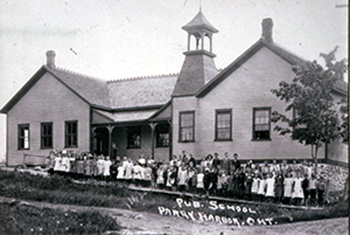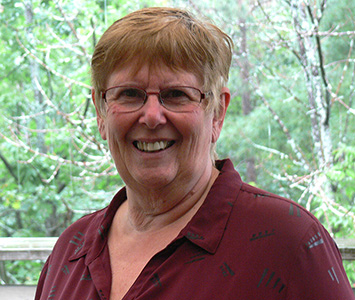Start Date: |
Sep 16/2016 |
Our Schools: Do You Remember? |
|
End Date: |
Nov 30/2016 |
| |
|
Our Schools: Do You Remember?
September 16th to November 30th

Did you know that there has been a school on the property where William Beatty is located since 1884 when Central School was built?
With the opening of the new Parry Sound Public School and the closing of Victory and William Beatty, we are turning a page in the history of Near North District Schools. Come celebrate education and learn about the history of the schools within the area by joining the Museum on Tower Hill for our upcoming exhibition Our Schools: Do You Remember?
Explore this back to school exhibition and recall the memories of your school days!
|
About the Curator:
Marianne Bourgeois
Marianne Bourgeois was born in Vancouver, British Columbia. She attended Simon Fraser University and taught in Smithers, B.C. for ten years before moving across Canada with her husband. Given that Bourgeois would have had to qualify in every province they resided in, she choose to remain out of the classroom until the couple finally settled in Burlington, Ontario. Bourgeois finished her degree in History at McMaster University and worked as a supply teacher for thirteen years. Once retired and living in Parry Sound, Bourgeois utilized her education as well as her teaching experience and pursued an interest in museums by volunteering at the Museum on Tower Hill. She has been with the museum for the last seven years. |

|
Museum on Tower Hill Communications Officer Sarah Caldwell sat down with Bourgeois to discuss the exhibition:
Caldwell: How has your career as an educator influenced this exhibition?
Bourgeois: I definitely think the reason why I was so interested in doing this exhibition is because of my background as a teacher. One of the things I really wanted to showcase is where they’ve shut down William Beatty School—there’s been a school on the property since 1884—so once we get rid of that school, it will be like turning a page in history of education in Parry Sound. I’ve always had an interest in schools and education so that’s where the impetus for trying to get this going came from.
Caldwell: Do you feel your background influenced the selections of objects?
Bourgeois: Oh, probably in a way. One of the things I was really interested in when they came in were the school registers because as a teacher that is something I had to fill out every day. It was very interesting to me to see how they had evolved over time. The other thing was the small hand bells they had for school, which is something I remember from when I was a child, and I thought, “Well, this is kind of neat”. So some of it, I think, is from my experiences as a teacher but some of it is also memories I have as a child going to a rural school.
Caldwell: So you went to a one-roomed school?
Bourgeois: Not a one-room, but I went to a school that was a four-room school in a small town in B.C. where every day someone got picked to run around and ring the bell to signal that school started and recess started. And we still had the desks that had the inkwells in them and stuff like that. That was in the late 1950s and in the school that I was in still had those double-sided desks that were attached to the floor, so it was definitely an older school.
Caldwell: Going through the collection, and during your research, did anything surprise you?
Bourgeois: One thing that really surprised me was how many schools there were. When I started the research for this, I had no idea there were that many schools. I started by looking at the townships that the district was divided in but some of the townships had up to eight schools so when you start multiplying that by the number of townships, the number of one-room log schools that were built in this area was enormous. When you start researching that, you realize that one of the reasons for that is the distance between the schools. For me, it was a bit of a learning curve because I had no idea there were that many.
Another thing was interesting was delving into the background of teaching and how it evolved. Prior to, I think it was 1847, you didn’t have to have any qualifications to teach. All you had to do was receive a Grade 8 education and you could go and teach in the schools. Then they passed a school education law and started opening up normal schools. That was kind of interesting for me too because it goes with my background as a teacher.
Caldwell: We found the board that had the Grade 8 exam. We could not pass that test.
(Laughter)
Bourgeois: I could not. I don’t think anyone could pass that test today.
Caldwell: Going back the collection, are they any objects that you would say are favourites in the exhibition?
Bourgeois: No, not really. I find all of them very interesting. Like I said, the hand bell brings back memories for me and the registers. One of the things I found very interesting, actually, is coming from McKellar and is a handmade yearbook made in 1947 by the kids who were graduating from Grade 10 in the McKellar school. They each made their own yearbook and I was blown away when I saw that. Now the kids get them when they graduate from Grade 12 but there was nothing in those days so each child made their own, and they wrote poems in them and it was kind of a joint effort I think, but each had their own handmade copies.
Caldwell: Do you know when yearbooks started becoming like a thing?
Bourgeois: That’s one thing I haven’t really looked at. I would probably think late 70s, early 80s before it became a tradition for a school to have yearbooks. I remember having them when I graduated so maybe it was earlier than that because I graduated in 1968. But also, it would depend on the type of school you were going to. McKellar school was a continuation school, which was a school that allowed to teach up to Grade 10 so once you graduated from Grade 8, you either came into Parry Sound to go to high school or some schools were designated as continuation schools where they would have a teacher who was qualified to teach those extra grades. A lot of the rural schools were continuation schools. One of the most interesting ones was the one in Sprucedale, which kids commuted to and from on the train. But a lot of kids who came into Parry Sound to go to high school boarded here. They would board with a family so they could go to high school.
Caldwell: What do you hope visitors will take away from the exhibition?
Bourgeois: That's why I called it "Do you Remember?" because I'm hoping it will trigger memories for people like it has for me. Memories of when you went to school. We will have class pictures and I'm hoping that people from the district might see themselves and it will bring back memories of when they went to school. A lot of older people went to some of these one room schools. Now, a lot of those people are getting older and we're losing them, and a lot of the histories I read during my research were written by people who had attended these schools. I think that's what I wanted to showcase. We've opened up this new school and that's like changing a page in history because that's over a hundred years of having a school in that one spot in Parry Sound. That it would showcase the schools that have been here and what the future might hold.
|


